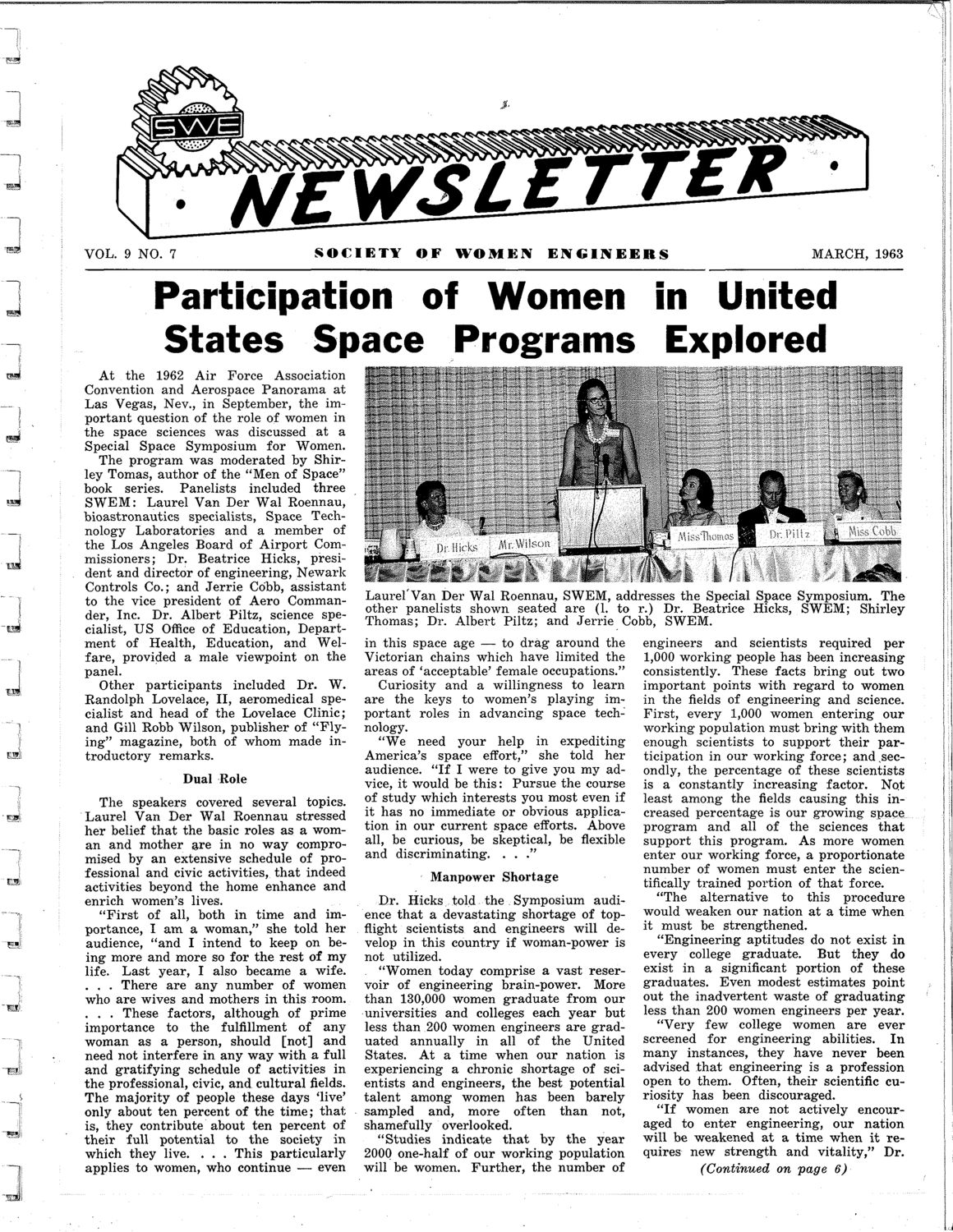| |
| |
Caption: SWE - News Clippings Book
This is a reduced-resolution page image for fast online browsing.

EXTRACTED TEXT FROM PAGE:
VOL. 9 NO. 7 SOCIETY OF WOMEN ENGINEERS MARCH, 1963 ion of Women in United States Space Programs Explored At the 1962 Air Force Association Convention and Aerospace Panorama at Las Vegas, Nev., in September, the important question of the role of women in the space sciences was discussed at a Special Space Symposium for Women. The program was moderated by Shirley Tomas, author of the "Men of Space" book series. Panelists included three SWEM: Laurel Van Der Wal Roennau, bioastronautics specialists, Space Technology Laboratories and a member of the Los Angeles Board of Airport Commissioners; Dr. Beatrice Hicks, president and director of engineering, Newark Controls Co.; and Jerrie Cobb, assistant to the vice president of Aero Commander, Inc. Dr. Albert Piltz, science specialist, US Office of Education, Department of Health, Education, and Welfare, provided a male viewpoint on the panel. Other participants included Dr. W. Randolph Lovelace, II, aeromedical specialist and head of the Lovelace Clinic; and Gill Robb Wilson, publisher of "Flying" magazine, both of whom made introductory remarks. Dual Role The speakers covered several topics. Laurel Van Der Wal Roennau stressed her belief that the basic roles as a woman and mother are in no way compromised by an extensive schedule of professional and civic activities, that indeed activities beyond the home enhance and enrich women's lives. "First of all, both in time and importance, I am a woman," she told her audience, "and I intend to keep on being more and more so for the rest of my life. Last year, I also became a wife. . . . There are any number of women who are wives and mothers in this room. . . . These factors, although of prime importance to the fulfillment of any woman as a person, should [not] and need not interfere in any way with a full and gratifying schedule of activities in the professional, civic, and cultural fields. The majority of people these days 'live' only about ten percent of the time; that is, they contribute about ten percent of their full potential to the society in which they live. . . . This particularly applies to women, who continue — even 6 Laurel'Van Der Wal Roennau, SWEM, addresses the Special Space Symposium. The other panelists shown seated are (1. to r.) Dr. Beatrice Hicks, SWEM; Shirley Thomas; Dr. Albert Piltz; and Jerrie Cobb, SWEM. in this space age — to drag around the Victorian chains which have limited the areas of 'acceptable' female occupations." Curiosity and a willingness to learn are the keys to women's playing important roles in advancing space technology. "We need your help in expediting America's space effort," she told her audience. "If I were to give you my advice, it would be this: Pursue the course of study which interests you most even if it has no immediate or obvious application in our current space efforts. Above all, be curious, be skeptical, be flexible and discriminating. . . ." Manpower Shortage Dr. Hicks told the Symposium audience that a devastating shortage of topflight scientists and engineers will develop in this country if woman-power is not utilized. "Women today comprise a vast reservoir of engineering brain-power. More than 130,000 women graduate from our universities and colleges each year but less than 200 women engineers are graduated annually in all of the United States. At a time when our nation is experiencing a chronic shortage of scientists and engineers, the best potential talent among women has been barely sampled and, more often than not, shamefully overlooked. "Studies indicate that by the year 2000 one-half of our working population will be women. Further, the number of engineers and scientists required per 1,000 working people has been increasing consistently. These facts bring out two important points with regard to women in the fields of engineering and science. First, every 1,000 women entering our working population must bring with them enough scientists to support their participation in our working force; and secondly, the percentage of these scientists is a constantly increasing factor. Not least among the fields causing this increased percentage is our growing space program and all of the sciences that support this program. As more women enter our working force, a proportionate number of women must enter the scientifically trained portion of that force. "The alternative to this procedure would weaken our nation at a time when it must be strengthened. "Engineering aptitudes do not exist in every college graduate. But they do exist in a significant portion of these graduates. Even modest estimates point out the inadvertent waste of graduating less than 200 women engineers per year. "Very few college women are ever screened for engineering abilities. In many instances, they have never been advised that engineering is a profession open to them. Often, their scientific curiosity has been discouraged. "If women are not actively encouraged to enter engineering, our nation will be weakened at a time when it requires new strength and vitality," Dr. (Continued on page 6)
| |